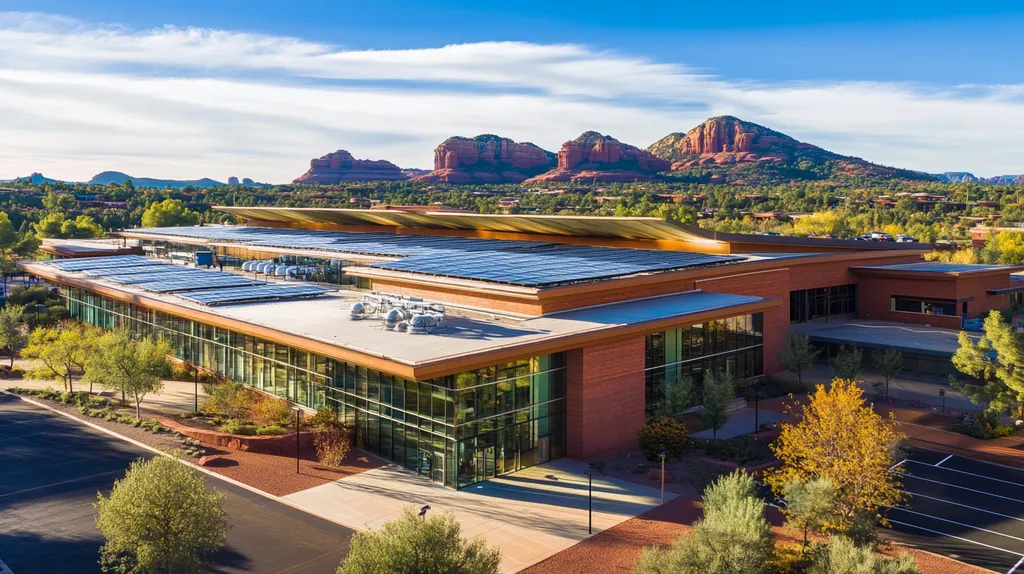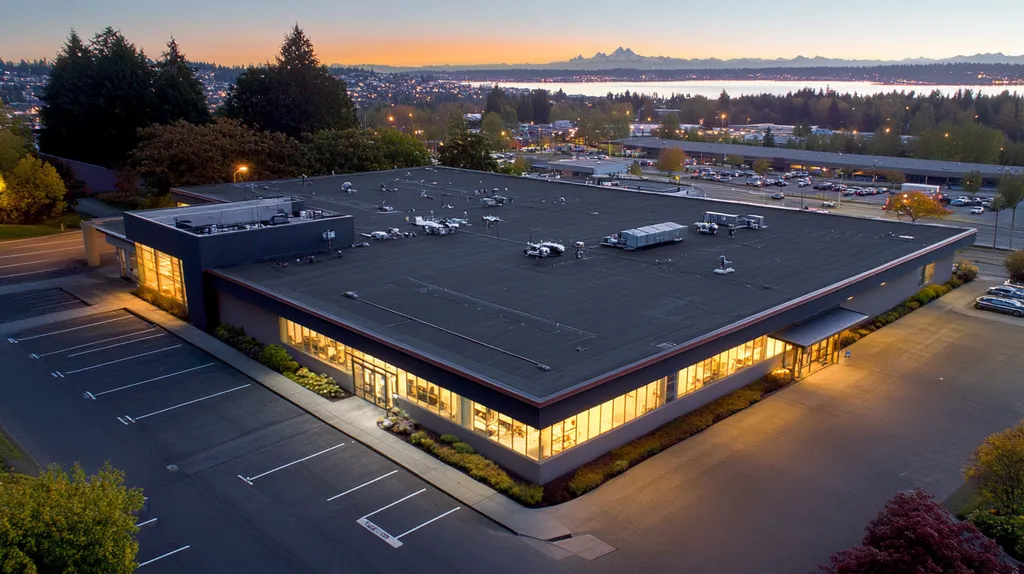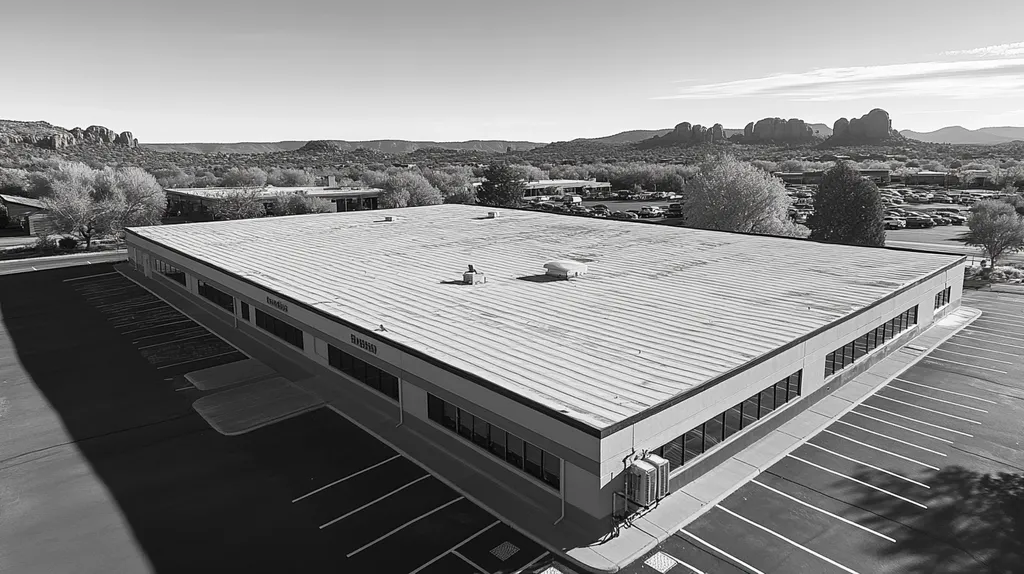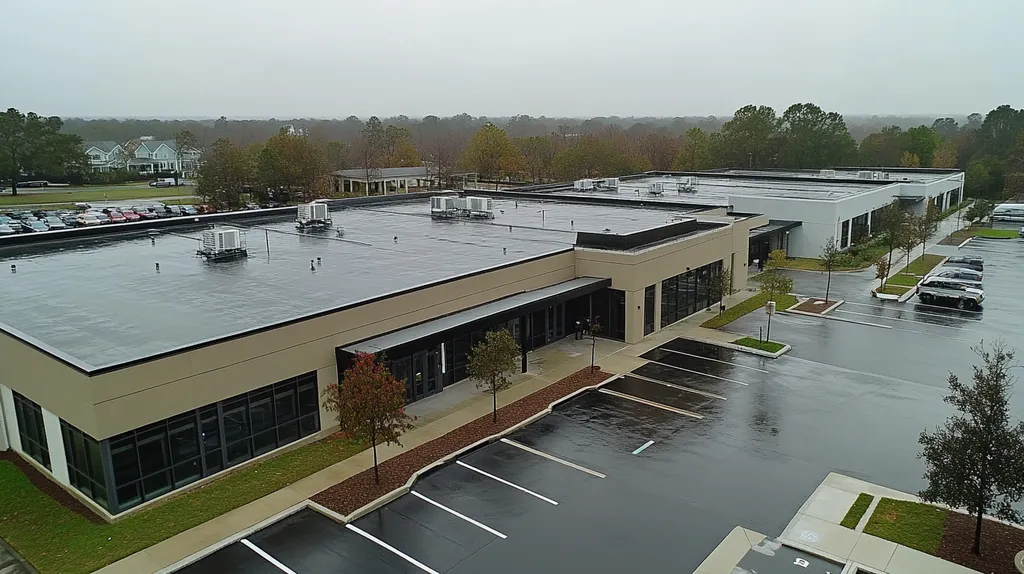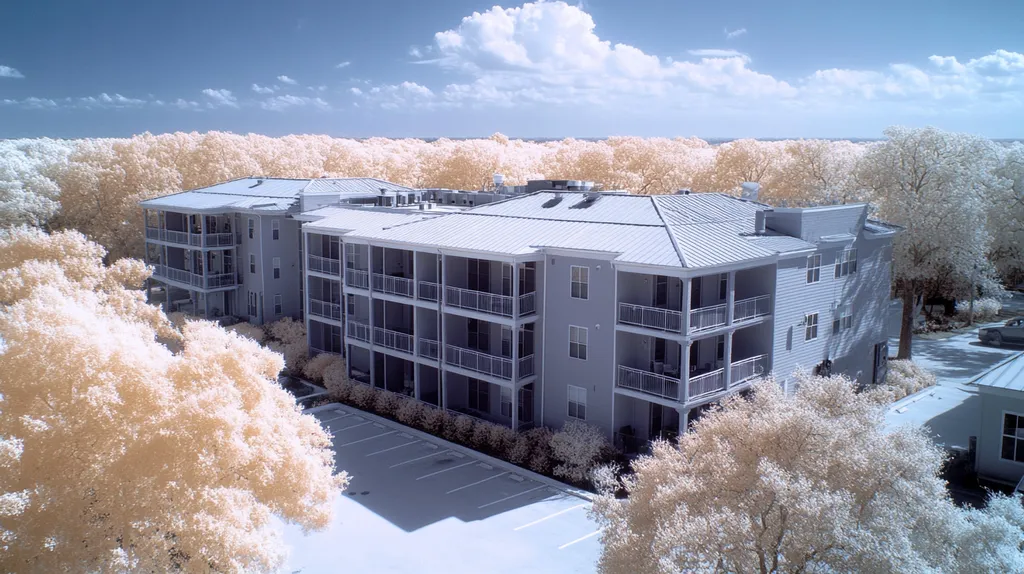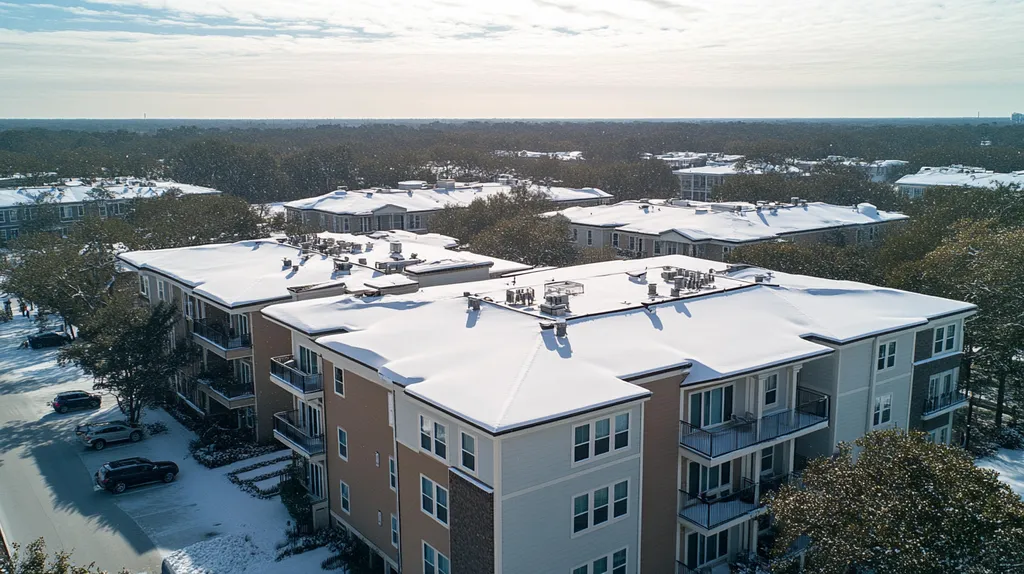In the high-stakes world of commercial roofing, proper licensing isn’t just paperwork—it’s the critical foundation that separates excellence from potential disaster. Industry data reveals that buildings with unlicensed roofing work are 73% more likely to experience catastrophic failures within the first five years.
From multi-million dollar liability claims to devastating structural collapses, the consequences of overlooking contractor licensing requirements can be severe. Yet navigating the complex web of state-specific regulations, insurance mandates, and qualification requirements leaves many property owners vulnerable.
This comprehensive guide demystifies the essential elements of commercial roofing licenses, equipping facility managers and property owners with the knowledge to ensure compliance, protect their investments, and avoid costly missteps.
SECTION 1: THE BASICS EXPLAINED
The world of commercial roofing comes with a significant responsibility: ensuring that buildings stay safe and sturdy. Understanding licensing requirements for commercial roofing contractors is not just a legal necessity; it’s crucial for protecting the integrity of your property. With a striking statistic from the National Roofing Contractors Association revealing that a staggering 15% of roofing failures arise from unlicensed contractors, it’s clear that knowing the licensing landscape is vital for property owners. This section will demystify what licensing means, why it holds such importance, and how it operates within the roofing industry, empowering you to make informed decisions.
What It Is (In Plain Language)
Licensing for commercial roofing contractors is like a badge of honor—but one that’s legally required and varies from state to state. It showcases that contractors possess the necessary training, knowledge, and experience. The journey to obtaining a license often involves passing rigorous exams and demonstrating real-world competency.
What does this mean for property owners? Simply put, licensed contractors are held to higher accountability standards than their unlicensed counterparts. This can directly influence everything from construction quality to adherence to essential safety protocols. Licensing ensures a contractor is well-versed in local building codes and best practices—saving you from headaches down the line.
On top of that, licensing provides a layer of consumer protection. Property owners can easily verify a contractor’s credentials, ensuring they hire a qualified professional. This safeguards against the risks associated with subpar workmanship, leading to a more reliable roofing experience.
In a nutshell, licensing serves as a crucial benchmark for service quality and reliability in the commercial roofing sector, ensuring the contractors you choose can effectively deliver on roofing projects.
Why It Matters (To Your Building)
Hiring a licensed commercial roofing contractor isn’t just a box to check—it’s essential for safeguarding the safety and longevity of your building. Allowing unlicensed work means opening the door to poor installations that can cause leaks, structural damage, or, in the worst-case scenario, roof collapses—serious safety risks for building occupants.
Another point to consider: many insurance policies mandate that roofs be installed by licensed professionals. When owners cut corners and hire unlicensed workers, they risk having their insurance claims denied, leading to significant financial fallout. By ensuring your contractor is licensed, you can save yourself costly repairs and potential legal hassles.
Research shows that buildings serviced by licensed contractors tend to experience fewer roofing-related issues over time. In a competitive property market, roofing quality can dramatically influence a building’s value.
In summary, bringing on a licensed contractor not only enhances your building’s safety but also reduces the chances of unexpected costs arising from poor workmanship or code violations—making your building a secure investment for years to come.
How It Works
The journey to obtaining a commercial roofing license typically involves several critical steps. Contractors often start by completing a set number of training or apprenticeship hours under seasoned professionals. This hands-on experience is invaluable in preparing them for the challenges of the job.
After gaining experience, candidates usually must pass written exams that test their knowledge of roofing techniques, materials, and local building codes. This thorough vetting process is vital to ensuring that only well-qualified individuals earn the privilege of working on commercial roofs.
Once licensed, contractors don’t just rest on their laurels; they typically must renew their licenses periodically, often through continuing education. This requirement keeps them informed about the latest industry standards and technologies, reinforcing their commitment to providing quality service.
In many areas, contractors may also be required to maintain specific types of insurance as a condition of their license. This coverage helps protect not just themselves but also property owners from liability in the event of accidents.
Ultimately, the licensing system has been designed with property owners in mind, ensuring their buildings are cared for by qualified professionals capable of delivering top-notch workmanship.
SECTION 2: PRACTICAL APPLICATIONS
Navigating the ins and outs of roofing licenses isn’t just a bureaucratic formality—it’s a critical safeguard for commercial property owners and facility managers. Ignoring licensing regulations can result in hefty fines and dangerous building conditions. For example, in states like Texas, large-scale roofing projects require specific licenses, putting property owners on the hook for liability if unlicensed work is performed. This section dives into the practical applications of roofing licenses, highlighting their common uses, when their importance peaks, and their relationships with other building systems.
Common Uses & Examples
Roofing licenses serve multiple practical functions, ensuring that contractors adhere to local building codes and safety standards. In states such as California and Florida, different license categories exist for various types of roofing work, distinguishing between residential and commercial responsibilities. This categorization aids property owners in selecting qualified professionals tailored to their specific needs.
Having a licensed contractor also signifies familiarity with the latest technologies and materials in the field. This knowledge enhances decision-making, allowing for better project outcomes. For example, licensed contractors can recommend energy-efficient roofing systems, ultimately leading to cost savings over time.
Additionally, licensed contractors are often required to carry insurance, providing added peace of mind for property owners. If damage occurs during installation, their insurance can help offset repair costs, alleviating financial strain on the building owner.
In short, roofing licenses are essential for ensuring quality, safety, and compliance. Property owners should always check that their contractors hold the necessary licenses to protect both their investments and operational safety.
When You Need It Most
Knowing when a roofing license is essential can help avoid compliance headaches. Specific scenarios dictate the need for licensed contractors, such as large-scale roof replacements or upgrades to sophisticated roofing systems. For instance, installing a new flat roof on a commercial building often requires a licensed professional who understands the unique complexities involved.
Furthermore, issues with existing roofs that show signs of structural distress necessitate licensed contractors. Engaging licensed experts protects building integrity and ensures adherence to local codes. Skipping out on a licensed contractor in these cases could result in subpar work that compromises safety.
Emergency repairs, too, showcase the need for licensed professionals. In the event of severe weather, property owners may feel the pressure to secure help quickly. But hiring an unlicensed contractor in a rush can lead to future complications, like overlooked damage or repairs that don’t meet local regulations.
Ultimately, verifying licensing before embarking on significant roofing projects is a proactive step that can save both money and legal troubles down the road.
Interactions With Other Systems
A comprehensive understanding of how roofing licenses interact with other building systems is essential for effective maintenance strategies. Roofing systems often play a critical role in conjunction with HVAC systems, and licensed roofing contractors typically have the expertise needed to collaborate effectively with HVAC technicians, maintaining safety compliance.
Moreover, roofing installations may impact fire protection and drainage systems, with state and local codes frequently mandating specific licenses for work that affects these areas. A knowledgeable licensed contractor will grasp the connections between roofing materials, the building envelope, and fire safety measures.
Adding solar panels to a roofing system introduces another layer of complexity, often requiring specialized knowledge and potentially an upgraded license. A licensed commercial roofer can provide guidance on the benefits and implications of integrating solar technology, keeping local regulations in mind.
In conclusion, proper licensing not only enhances quality and compliance but also fosters collaboration among various professionals involved in building maintenance. This coordinated approach ensures a functional, sustainable environment, benefiting everyone involved.
SECTION 3: KEY TERMINOLOGY DECODED
Grasping the terminology in commercial roofing is not merely academic; it can save property owners and facility managers from tangled contracts, costly mistakes, and dangerous oversights. Consider the term “thermal resistance”—misunderstanding it could lead to subpar insulation, driving up energy costs and compromising comfort. This section will illuminate essential roofing terms, unravel industry jargon, and simplify key measurements that are crucial for navigating roofing licenses and compliance.
Essential Terms Explained
Understanding the difference between “licensure” and “certification” is foundational. Licensure represents legal permission for a contractor to work in a specific area, while certification usually indicates adherence to certain industry standards—though it may not be legally required.
Next, the term “roofing system” refers to the combination of elements that comprise a roof, including underlayment, insulation, and the final surface. This knowledge empowers property owners to choose systems that align with local building codes and requirements.
Another term to grasp is “contractor bonds.” These are financial assurances that protect clients, providing recourse if a contractor fails to fulfill their obligations. If work is left incomplete, the bond can kick in to cover damages or finish the job.
Lastly, “green roofing” describes environmentally friendly systems designed to minimize ecological impacts. Understanding this term aids in selecting sustainable options, supporting both compliance with local regulations and environmental stewardship.
Industry Jargon Translated
The roofing industry is rife with jargon that can leave property owners scratching their heads. Take “R-value,” for instance. This term measures how well insulation resists heat flow—higher R-values indicate better insulation, which can translate to lower energy bills.
Don’t overlook “flashing,” either, as it refers to materials used at roof joints to prevent leaks. Ignoring the significance of flashing can expose your roof to vulnerabilities that may lead to costly repairs.
Phrases like “pitch” and “slope” are critical as well. Pitch refers to how steeply a roof rises, directly influencing water drainage. A low-pitch roof requires different materials than a steep one, affecting both compliance and longevity.
Lastly, “drainage” is key in roof design. Effective drainage systems prevent water from pooling and mitigate risks of structural damage and safety hazards. Familiarity with these terms is crucial to making informed decisions in roofing projects.
Measurement & Units Simplified
Measurements play a starring role in successful roofing endeavors. For instance, square footage is critical for determining the amount of roofing material needed. Learning to convert between feet and inches can impact material estimates and costs considerably.
A vital measurement is “pitch,” expressed as a rise-to-run ratio, such as 4:12. Understanding this ratio influences material choices and the overall aesthetics of your building.
Units like “PSF” (pounds per square foot) gauge load capacity. Recognizing how much weight your roof can handle helps ensure it withstands not only its own heft but also that of snow, rain, or equipment.
Finally, “gutter size” matters more than one might think. Properly sized gutters help prevent overflow and subsequent water damage, emphasizing the need for precise measurements in roofing compliance.
SECTION 4: DECISION FACTORS
Deciding on the best commercial roofing solution is not a trivial pursuit; it’s a matter of safety, durability, and financial prudence. With the average roofing project costing between $150,000 and $300,000, the choices made during this process have far-reaching implications. Evaluating cost, performance, and lifespan is essential to avoid pitfalls that could put both investments and operations at risk. This section will illuminate the crucial decision factors that can guide your roofing project toward success.
Cost Considerations
Understanding the financial landscape of commercial roofing is vital for effective budgeting. While attractive upfront costs may lure property owners in, they can often hide more significant long-term expenses. For example, choosing the cheapest materials could result in a carousel of repairs, eventually costing far more than investing in quality upfront.
Labor costs should not be overlooked either. Hiring a licensed contractor may seem pricier initially, but their expertise ensures superior installation and minimizes future headaches. In this case, investing wisely pays dividends over time, as quality workmanship can lead to fewer complications.
It’s also essential to consider the financial fallout of project delays. Postponements can lead to costly internal damage, making the initial investment in durable materials a wise choice. Evaluating your budget’s totality can keep your financial picture clear.
Finally, explore financing options to ease any budget constraints. Understanding different financial pathways can lead to decisions that balance immediate needs with long-term security.
Performance Trade-offs
The performance of roofing materials has a significant impact on overall building operations. Choosing a roof based solely on cost could undermine insulation and energy efficiency. For instance, low-grade materials might lead to spikes in energy bills due to poor thermal resistance.
Durability deserves serious consideration as well. Some roofing systems may tempt with short-term savings but fall short on longevity. A higher upfront investment in long-lasting materials can prove to be a cost-effective choice in the grand scheme of things.
Weather resistance is another paramount factor. In regions prone to inclement weather, durable roofing materials are essential. Investing in performance-driven solutions not only protects your building but ensures operational continuity.
Additionally, advanced innovations like reflective coatings can lead to impressive performance gains. While these options might carry a higher price tag initially, they can ultimately reduce cooling costs and extend the life of your roof.
Lifespan & Durability Factors
The expected lifespan of a roofing system is a pivotal decision-making element. A roof designed to last longer minimizes the frequency of replacements and the overall cost of ownership. Property owners should carefully evaluate warranties to understand what’s covered and for how long.
Durability is key to longevity. High-quality materials that withstand environmental challenges are paramount. For example, roofs that use reinforced membranes may endure significantly longer than standard options, reducing the interruptions to business activities.
Climate considerations also come into play. Roofs in harsher weather conditions will naturally have shorter lifespans. Selecting materials tailored to local climates can make a big difference in durability and restoration costs.
Lastly, proactive maintenance plans significantly affect a roof’s lifespan. Regular inspections facilitate early issue detection, allowing for timely repairs. Properties that prioritize maintenance typically enjoy longer-lasting roofs and enhanced performance.
SECTION 5: COMMON CHALLENGES
The arena of commercial roofing is riddled with obstacles that can derail compliance and undermine project success. With up to 30% of roofing projects facing delays due to licensing snafus, property owners and facility managers must navigate these challenges to safeguard their investments. Misunderstanding local regulations, failing to verify contractor credentials, and keeping pace with evolving requirements can all lead to significant setbacks. This section explores common issues, warning signs to be aware of, and preventative steps to enhance compliance and quality.
Frequent Problems & Solutions
One of the most prevalent challenges is the swirling sea of licensing requirements that change often across various regions. Contractors may find it tough to stay afloat amidst these changes, risking non-compliance and incurring penalties. Regular updates from the industry and ongoing education are invaluable lifelines that can help contractors navigate this turbulent water.
Another common pitfall is the insufficient verification of a contractor’s licenses. Property owners sometimes skip this critical check, which can open the door to serious liability issues. Implementing a straightforward checklist that includes license verification can serve as a proactive shield against these risks.
Losing track of necessary documents due to poor record-keeping can also create chaos on a project. Contractors might struggle to locate permits or required paperwork when the time comes. Establishing a centralized documentation system can organize compliance efforts and make all necessary information readily available.
Warning Signs To Watch For
Property owners must stay alert for red flags during the contractor selection process. If a contractor cannot produce required licenses or proof of insurance, it’s a clear warning sign. Vague claims about experience or qualifications can also indicate deeper issues beneath the surface.
Another warning sign is a contractor’s inability to articulate local laws and requirements. If they seem unsure or uninformed, they may be more likely to cut corners, jeopardizing the entire project. Asking pointed questions about local regulations can reveal a contractor’s grasp of necessary compliance.
A history of complaints or disputes can further signal that a contractor might not follow licensing regulations closely. Exploring online reviews and reaching out to previous clients can help unearth information that suggests unreliability and non-compliance.
Preventative Approaches
To steer clear of compliance issues, property owners should take their time in the hiring process by conducting thorough due diligence on roofing contractors. This means verifying licenses, confirming insurance coverage, and checking previous project references. Crafting a detailed list of questions can help ensure that the chosen contractor has a solid reputation.
Investing in training and continuous education for contractors is another significant strategy to keep licensing knowledge current. Encouraging professionals to embrace ongoing development will not only enhance individual competency but also strengthen the roofing industry as a whole.
Finally, maintaining open communication lines with contractors throughout the project is essential. Regular check-ins can clarify expectations and quickly address compliance concerns as they arise, reducing the risk of complications down the line.
SECTION 6: NEXT STEPS & RESOURCES
In the ever-changing maze of commercial roofing regulations, staying ahead of the game is vital for property owners and facility managers. Non-compliance can open the door to hefty fines, delays in projects, and serious safety risks. By asking the right questions, understanding industry standards, and tapping into educational resources, owners can make savvy decisions. This section offers practical steps and valuable resources to help navigate the licensing landscape with confidence.
Questions To Ask Providers
When considering potential roofing contractors, property owners should focus on asking pointed questions that gauge qualifications. Start with the basics: request the contractor’s license number and confirm that it is current and valid in the local area. Insurance coverage should also be on the checklist, as this is crucial for protecting both the property and the workers involved.
Next, delve into warranty options for both materials and workmanship. Such inquiries shed light on the contractor’s commitment to quality, showing how they back their work. Understanding their past experience with similar roofing projects can provide further insight into their capability to tackle specific challenges.
Lastly, request references from previous clients to bolster confidence in the contractor’s reliability and performance. These questions help ensure that property owners engage with licensed, insured, and reputable professionals capable of delivering top-notch results.
Industry Standards & Guidelines
Knowing the industry standards is like having a roadmap for successful roofing projects. Key guidelines dictate how licensed roofing contractors operate, making compliance essential for reducing liability. The National Roofing Contractors Association (NRCA) outlines best practices that encompass safety protocols, material specifications, and installation techniques.
Moreover, local building codes come into play, stipulating specific requirements that must be adhered to during roofing tasks. These codes can vary significantly, covering aspects from the types of materials allowed to installation methods and environmental concerns related to drainage and insulation.
Staying informed about these standards not only guarantees compliance but also promotes a culture of safety and excellence among contractors. Joining local trade organizations can provide valuable insights into current trends and regulatory shifts impacting the roofing industry.
Further Learning Simplified
Continuing education is key for property owners and facility managers looking to elevate their roofing knowledge. Numerous resources, including online courses, webinars, and workshops, are offered by industry associations. These platforms distill complex topics, covering everything from advancements in roofing technology to sustainability practices and the latest regulatory updates.
Websites like the NRCA and the Roofing Industry Educational Institute (RIEI) serve up accessible educational materials that simplify intricate subjects. For those who prefer hands-on learning, local trade shows and conferences present excellent opportunities to meet experts and explore the newest products and techniques.
Investing time in these educational avenues enables property owners and facility managers to make well-informed decisions, ensuring roofing projects are successful and compliant.
The Bottom Line
With over $12 billion in annual commercial roofing claims tied to improper licensing, the stakes couldn’t be higher for property owners and facility managers.
Understanding and verifying contractor licensing isn’t just about regulatory compliance—it’s about protecting massive investments and ensuring occupant safety.
The landscape of commercial roofing licenses continues to evolve, with new regulations and requirements emerging regularly across different jurisdictions.
Smart property owners recognize that proper licensing verification is their first line of defense against costly failures, legal liability, and insurance claim denials.
By staying informed about licensing requirements and working exclusively with properly credentialed contractors, facility managers can dramatically reduce risk while maximizing the longevity and performance of their roofing systems.
FREQUENTLY ASKED QUESTIONS
Q. What are licenses for commercial roofing contractors?
A. Licenses demonstrate a contractor’s qualifications and adherence to local regulations. They ensure contractors possess necessary training and experience, which is crucial for meeting safety and quality standards in roofing. Hiring a licensed contractor significantly reduces the risks of poor workmanship and legal issues.
Q. When is it necessary to hire licensed contractors for an industrial roof?
A. It’s vital to hire licensed professionals for significant repairs, replacements, or any structural alterations. When dealing with complex systems, such as flat roofs, licensed experts ensure compliance with local building codes and safety standards, safeguarding your property’s integrity during substantial work.
Q. What key terms should I know for commercial roofing?
A. Understanding terms like “licensure,” “roofing system,” and “contractor bonds” is essential. Licensure refers to the legal approval for contractors to work, while contractor bonds offer protection for clients against incomplete work. Grasping these concepts helps property owners navigate projects confidently.
Q. How do I make an informed decision for my commercial roof?
A. Evaluate factors like cost, material durability, and lifespan when choosing. Understand that opting for cheaper materials may escalate future repair costs. Prioritize hiring licensed contractors for quality installation, which ensures that your roof meets local regulations and lasts longer, promoting financial sustainability.
Q. What common challenges do property owners face with roofing licenses?
A. Frequent issues include misunderstanding local regulations and failing to verify contractor licensure. Non-compliance can lead to significant delays and legal repercussions. It’s critical for property owners to stay informed about changing regulations and perform due diligence when selecting contractors.
Q. What resources can help me stay compliant with commercial roofing regulations?
A. Use resources such as the National Roofing Contractors Association for guidance on industry standards. Joining local trade organizations keeps you informed about regulations and best practices. Educational platforms and workshops offer continuous learning, enhancing compliance knowledge and skills in roofing management.
Q. How can I verify if a contractor is licensed for commercial roofing?
A. Request the contractor’s license number and check it against your state’s licensing board database. Additionally, ask for proof of insurance and review client references to validate their credibility. Ensuring the contractor is properly licensed helps protect your investment and ensures quality work.

